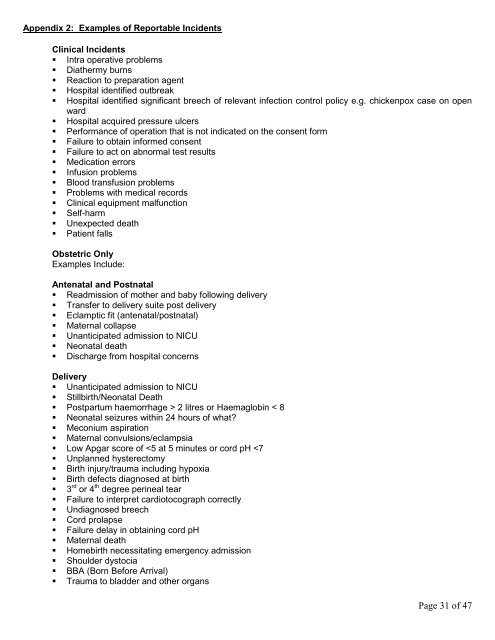Incident reporting policy - Homerton University Hospital
Incident reporting policy - Homerton University Hospital Incident reporting policy - Homerton University Hospital
Table 2 Likelihood score (L)What is the likelihood of the consequence occurring?The frequency-based score is appropriate in most circumstances and is easier to identify. It should be usedwhenever it is possible to identify a frequency.Likelihood score 1 2 3 4 5Descriptor Rare Unlikely Possible Likely Almost certainProbabilityHow often mightit/does it happenThis will probablyneverhappen/recurDo not expect it tohappen/recur butit is possible itmay do soMight happen orrecur occasionally Will probablyhappen/recur butit is not apersisting issueWillundoubtedlyhappen/recur,possiblyfrequentlyFrequencyNot expected tooccur for yearsExpected to occurat least annuallyExpected to occurat least monthlyExpected to occurat least weeklyExpected tooccur at leastdailyTable 3 Risk scoring = consequence x likelihood (C x L )LikelihoodscoreLikelihood1 2 3 4 5Rare Unlikely Possible Likely5 Catastrophic 5 10 15 20 254 Major 4 8 12 16 203 Moderate 3 6 9 12 152 Minor 2 4 6 8 101 Negligible 1 2 3 4 5For grading risk, the scores obtained from the risk matrix are assigned grades as follows1 - 3 Low Risk4 - 6 Moderate Risk8 - 12 High Risk15 - 25 Extreme RiskAlmostcertainInstructions for use1. Use table 1 to determine the consequence score(s) (C) for the potential adverse outcome(s) relevant tothe risk being evaluated.2. Use table 2 to determine the likelihood score(s) (L) for those adverse outcomes. If possible, score thelikelihood by assigning a predicted frequency of occurrence of the adverse outcome. If this is not possible,assign a probability to the adverse outcome occurring within a given time frame, such as the lifetime of aproject or a patient care episode. If it is not possible to determine a numerical probability then use theprobability descriptions to determine the most appropriate score.3. Calculate the risk score the risk multiplying the consequence by the likelihood: C (consequence) x L(likelihood) = R (risk score)Page 30 of 47
Appendix 2: Examples of Reportable IncidentsClinical Incidents• Intra operative problems• Diathermy burns• Reaction to preparation agent• Hospital identified outbreak• Hospital identified significant breech of relevant infection control policy e.g. chickenpox case on openward• Hospital acquired pressure ulcers• Performance of operation that is not indicated on the consent form• Failure to obtain informed consent• Failure to act on abnormal test results• Medication errors• Infusion problems• Blood transfusion problems• Problems with medical records• Clinical equipment malfunction• Self-harm• Unexpected death• Patient fallsObstetric OnlyExamples Include:Antenatal and Postnatal• Readmission of mother and baby following delivery• Transfer to delivery suite post delivery• Eclamptic fit (antenatal/postnatal)• Maternal collapse• Unanticipated admission to NICU• Neonatal death• Discharge from hospital concernsDelivery• Unanticipated admission to NICU• Stillbirth/Neonatal Death• Postpartum haemorrhage > 2 litres or Haemaglobin < 8• Neonatal seizures within 24 hours of what?• Meconium aspiration• Maternal convulsions/eclampsia• Low Apgar score of
- Page 3: 1.0 Version ControlVersion Date Aut
- Page 6 and 7: 6.0 Policy Definitions6.1 Adverse I
- Page 8 and 9: The person in charge at the time of
- Page 10 and 11: • Review sessions throughout the
- Page 12 and 13: They refer serious incident investi
- Page 14 and 15: Level of Incident Process Investiga
- Page 16 and 17: 17.3 Communication with StaffIt wil
- Page 18 and 19: Trust‟s Raising Concerns at Work
- Page 20 and 21: o action or lack of action by a mem
- Page 22 and 23: In the event of a suspected SUI it
- Page 24 and 25: managers determine how staff can be
- Page 26 and 27: In cases where there may be legal i
- Page 28 and 29: Appendix 1: Incident Risk Assessmen
- Page 32 and 33: Community• Unplanned homebirth•
- Page 34 and 35: Appendix 4: Reporting to External A
- Page 36 and 37: Appendix 5: Reportable injuries or
- Page 38 and 39: Appendix 6MEMORANDUM OF UNDERSTANDI
- Page 40 and 41: Appendix 8: Infection Control Serio
- Page 42 and 43: Appendix 10 - 24 Hour Meeting Agend
- Page 44 and 45: Equalities Impact AssessmentThis ch
- Page 46 and 47: Policy Submission FormPolicy Submis
Appendix 2: Examples of Reportable <strong>Incident</strong>sClinical <strong>Incident</strong>s• Intra operative problems• Diathermy burns• Reaction to preparation agent• <strong>Hospital</strong> identified outbreak• <strong>Hospital</strong> identified significant breech of relevant infection control <strong>policy</strong> e.g. chickenpox case on openward• <strong>Hospital</strong> acquired pressure ulcers• Performance of operation that is not indicated on the consent form• Failure to obtain informed consent• Failure to act on abnormal test results• Medication errors• Infusion problems• Blood transfusion problems• Problems with medical records• Clinical equipment malfunction• Self-harm• Unexpected death• Patient fallsObstetric OnlyExamples Include:Antenatal and Postnatal• Readmission of mother and baby following delivery• Transfer to delivery suite post delivery• Eclamptic fit (antenatal/postnatal)• Maternal collapse• Unanticipated admission to NICU• Neonatal death• Discharge from hospital concernsDelivery• Unanticipated admission to NICU• Stillbirth/Neonatal Death• Postpartum haemorrhage > 2 litres or Haemaglobin < 8• Neonatal seizures within 24 hours of what?• Meconium aspiration• Maternal convulsions/eclampsia• Low Apgar score of



